牛津版七年级英语预备课程教案
- 格式:doc
- 大小:161.50 KB
- 文档页数:36
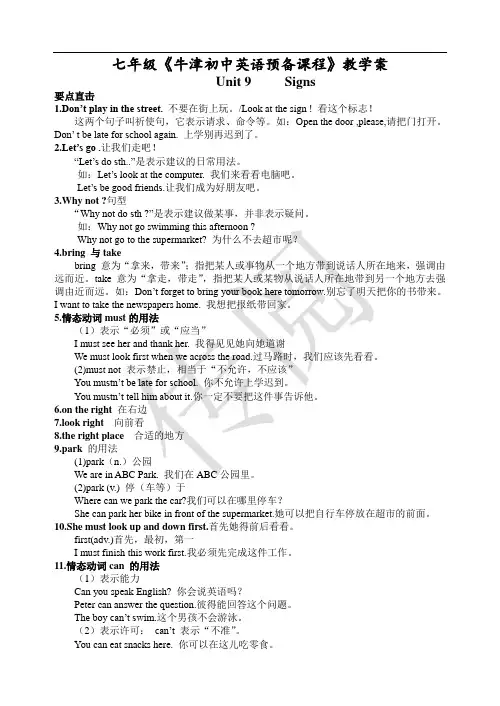
七年级《牛津初中英语预备课程》教学案Unit 9 Signs要点直击1.Don’t play in the street. 不要在街上玩。
/Look at the sign ! 看这个标志!这两个句子叫祈使句,它表示请求、命令等。
如:Open the door ,please,请把门打开。
Don’ t be late for school again. 上学别再迟到了。
2.Let’s go .让我们走吧!“Let’s do sth..”是表示建议的日常用法。
如:Let’s look at the computer. 我们来看看电脑吧。
L et’s be good friends.让我们成为好朋友吧。
3.Why not ?句型“W hy not do sth ?”是表示建议做某事,并非表示疑问。
如:Why not go swimming this afternoon ?Why not go to the supermarket? 为什么不去超市呢?4.bring 与takebring 意为“拿来,带来”;指把某人或事物从一个地方带到说话人所在地来,强调由远而近。
take 意为“拿走,带走”,指把某人或某物从说话人所在地带到另一个地方去强调由近而远。
如:Don’t forget to bring your book here tomorrow.别忘了明天把你的书带来。
I want to take the newspapers home. 我想把报纸带回家。
5.情态动词must的用法(1)表示“必须”或“应当”I must see her and thank her. 我得见见她向她道谢We must look first when we across the road.过马路时,我们应该先看看。
(2)must not 表示禁止,相当于“不允许,不应该”You mustn’t be late for school. 你不允许上学迟到。
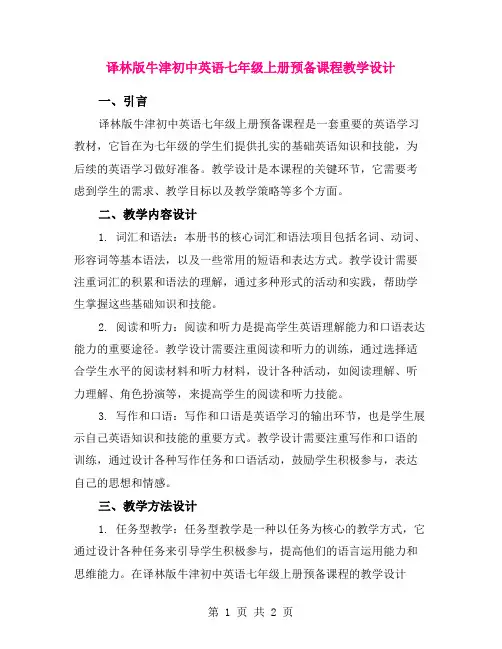
译林版牛津初中英语七年级上册预备课程教学设计一、引言译林版牛津初中英语七年级上册预备课程是一套重要的英语学习教材,它旨在为七年级的学生们提供扎实的基础英语知识和技能,为后续的英语学习做好准备。
教学设计是本课程的关键环节,它需要考虑到学生的需求、教学目标以及教学策略等多个方面。
二、教学内容设计1. 词汇和语法:本册书的核心词汇和语法项目包括名词、动词、形容词等基本语法,以及一些常用的短语和表达方式。
教学设计需要注重词汇的积累和语法的理解,通过多种形式的活动和实践,帮助学生掌握这些基础知识和技能。
2. 阅读和听力:阅读和听力是提高学生英语理解能力和口语表达能力的重要途径。
教学设计需要注重阅读和听力的训练,通过选择适合学生水平的阅读材料和听力材料,设计各种活动,如阅读理解、听力理解、角色扮演等,来提高学生的阅读和听力技能。
3. 写作和口语:写作和口语是英语学习的输出环节,也是学生展示自己英语知识和技能的重要方式。
教学设计需要注重写作和口语的训练,通过设计各种写作任务和口语活动,鼓励学生积极参与,表达自己的思想和情感。
三、教学方法设计1. 任务型教学:任务型教学是一种以任务为核心的教学方式,它通过设计各种任务来引导学生积极参与,提高他们的语言运用能力和思维能力。
在译林版牛津初中英语七年级上册预备课程的教学设计中,可以运用任务型教学,设计各种任务,如角色扮演、小组讨论、演讲等,来激发学生的学习兴趣和积极性。
2. 情境式教学:情境式教学是一种通过创设真实的或模拟的情境来帮助学生理解和运用知识的教学方式。
在译林版牛津初中英语七年级上册预备课程的教学设计中,可以运用情境式教学,设计各种情境化的教学活动,如对话练习、故事编写等,来提高学生的英语运用能力。
四、教学评估与反馈教学评估是教学设计的重要组成部分,它可以帮助教师了解学生的学习情况,及时调整教学策略和方法。
在教学设计中,教师需要注重教学评估的设计,如课堂观察、作业评价、测试等,同时也要注重学生的反馈和意见,及时调整自己的教学方式和方法。
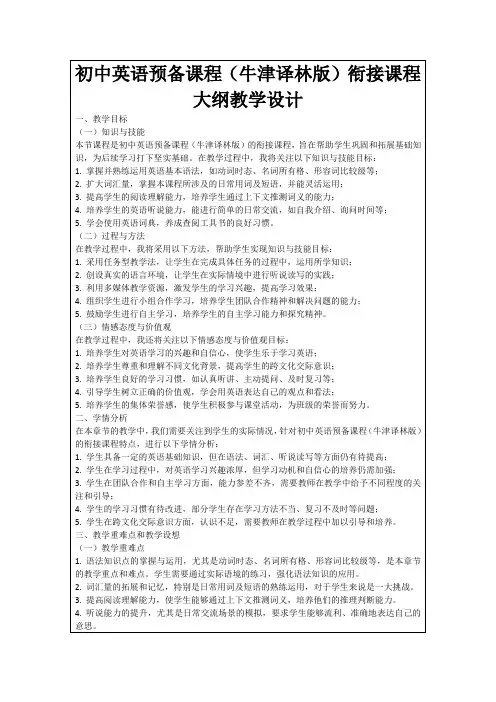
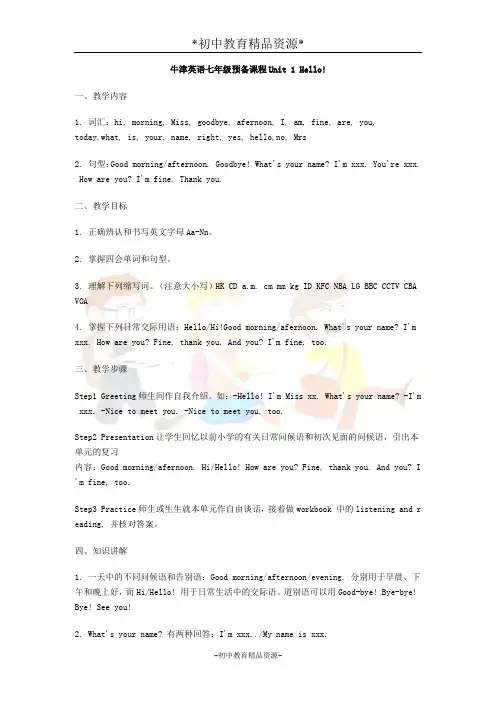
牛津英语七年级预备课程Unit 1 Hello!一、教学内容1. 词汇:hi, morning, Miss, goodbye, afernoon, I, am, fine, are, you,today,what, is, your, name, right, yes, hello,no, Mrs2. 句型:Good morning/afternoon. Goodbye! What's your name? I'm xxx. You're xxx. How are you? I'm fine. Thank you.二、教学目标1. 正确辨认和书写英文字母Aa-Nn。
2. 掌握四会单词和句型。
3. 理解下列缩写词。
(注意大小写)HK CD a.m. cm mm kg ID KFC NBA LG BBC CCTV CBA VOA4. 掌握下列日常交际用语:Hello/Hi!Good morning/afernoon. What's your name? I'm xxx. How are you? Fine, thank you. And you? I'm fine, too.三、教学步骤Step1 Greeting师生间作自我介绍。
如:-Hello! I'm Miss xx. What's your name? -I'm xxx. -Nice to meet you. -Nice to meet you, too.Step2 Presentation让学生回忆以前小学的有关日常问候语和初次见面的问候语,引出本单元的复习内容:Good morning/afernoon. Hi/Hello! How are you? Fine, thank you. And you? I 'm fine, too.Step3 Practice师生或生生就本单元作自由谈话,接着做workbook 中的listening and r eading, 并核对答案。
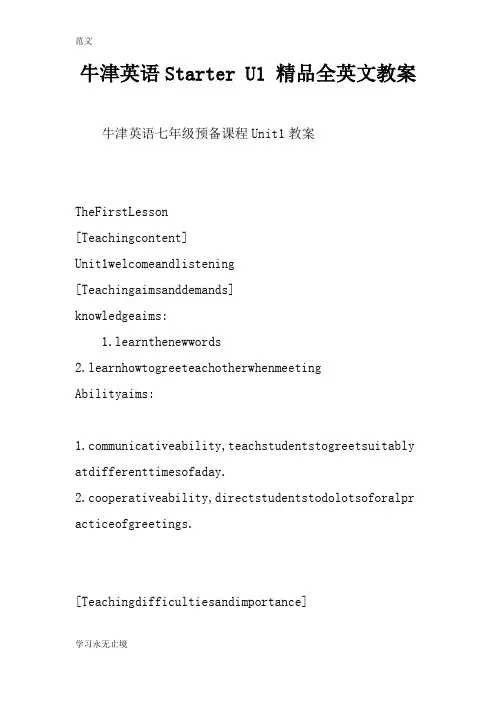
牛津英语Starter U1 精品全英文教案牛津英语七年级预备课程Unit1教案TheFirstLesson[Teachingcontent]Unit1welcomeandlistening [Teachingaimsanddemands]knowledgeaims:1.learnthenewwords2.learnhowtogreeteachotherwhenmeetingAbilityaims:municativeability,teachstudentstogreetsuitably atdifferenttimesofaday.2.cooperativeability,directstudentstodolotsoforalpr acticeofgreetings.[Teachingdifficultiesandimportance]1.Payattentiontothespellingofthesewords:bye,hello,r ight,mr,andmrs.2.Howtogreetsuitablyatdifferenttimesofadayandgreeti ndifferentways.[Teachingtools]Projector,Students’bookandworkbook[Teachingsteps]Pre-teaching1.Teachthenewwords Askthestudentstoreadallofthenewwordsbeforeteaching. onestudentsreadsfivewords,sothattheteachercanfindou ttheirmistakesinphoneticsandthencorrect.2.Askallstudentstoreadallofthenewwords,sothattheyar efamiliarwiththembeforegoingintothetext.3.Theteacherneedn’tleadthemtoreadthenewwords,becausethosearewordswhic hstudentshavealreadylearnedintheprimaryschool,andth eyareallveryeasyandusualwords.4.Asforthespellingofthenewwords,therearesomeinwhich studentsalwayshavedifficulty,suchas,bye,hello,right ,mr,andmrs.Step1.warm-upandPresentation makeSsrecallthegreetingswhichtheylearnedintheprimar yschoolbydoingsomecommonandeasygreetingswithstudent s,leadingtothesubjectofthisunit.Step2.welcometothisunit1.Askstudentstoreadthefourdialoguesofthispartfortwice ,andgetreadyforthefollowingquestionstocheckifthestu dentsunderstandthemeaningofthedialogues: whoisAndy?whoismillie?whoisLily?whoisNick?whoismissFang?whentheymeet,whatdotheysay?whentheymeetinthemorning,whatdotheysay?whentheypart,whatdotheysay?2.Teachstudentssomesimilarwordsandsimilarsentencesoft hefourdialogues,andatthesametimeaskthemtoreplaceall ofthenamesinthedialogueswiththethosesoftheirclassma tes.Therefore,studentscanmakeanotherfourdialoguesof theirownandofdifferentpatternsbutofthesamemeaning. Forexample,Hi=Hello,Goodmorning=Goodmorningtoyou, Goodbye=Bye-bye,Bye,Seeyou,seeyouaround,seeyoulater 3.PairworkandashowtimeStep3Listening1.Pre-listening.ThereisaclockonthewallinPicture1ofPartA,soaskSsforthecorrecttime.Afterthattheteacherguidesthestudentst oobservethetimesoftheotherthreedialoguesinthisparta ndteachesthedifferentwaysofgreeting.2.Askstudentstodothelisteningexercisesonthetapeandtic kthecorrectanswer.3.Dosomepost-listeningwork.Guidestudentstoreplaceallo fthenamesinthedialogueswiththenamesoftheirclassmate sandusesomesimilarwordsandsimilarsentencestomakeano therdialogueoftheirown,sothatSscanknowthedifferentw aysofgreeting.Forexample,Goodafternoon=Goodafternoontoyou, Howareyou=Howareyoudoing,I’mfine=I’mok,ok,Fine,Good,Great,hi=hello,Andyou=whataboutyou, Thankyou=Thanks4.Pairworkandashowtime5.Summary,askSstofindandlearnthesedifferentwaystogreeteachother.1).youknoweachother:Hi,goodmorning/afternoon;Howareyou?2).youdon’tknoweachother:Hello,what’syourname?3).youdon’tknoweachother,butyouknoweachother’sname: Hello,you’re----,right?Step4Furtherknowledgeandability1.Howareyou?的回答一般是肯定,它的不同回答有: Fine,thankyou./I'mfine,thankyou./Notbad,thankyou./I'mok/verywell/Allright./justso-so.身体状况确实不好,我们可以说:Notsogood/Terrible/Idon’tfeelingverywell.2.对女性和男性的称呼如下:对男性我们一律称mr.soandso,对未婚女性我们称misssoandso,而对已婚和不明婚姻状况的女性分别称mrs.soandso,和mssoandso.,并将mr.mrs.或miss,ms放在姓之前。
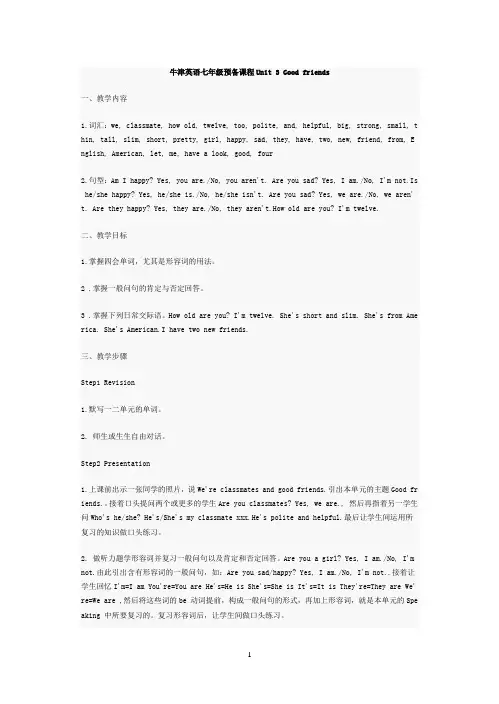
牛津英语七年级预备课程Unit 3 Good friends一、教学内容1.词汇:we, classmate, how old, twelve, too, polite, and, helpful, big, strong, small, t hin, tall, slim, short, pretty, girl, happy, sad, they, have, two, new, friend, from, E nglish, American, let, me, have a look, good, four2.句型:Am I happy? Yes, you are./No, you aren't. Are you sad? Yes, I am./No, I'm not.Is he/she happy? Yes, he/she is./No, he/she isn't. Are you sad? Yes, we are./No, we aren' t. Are they happy? Yes, they are./No, they aren't.How old are you? I'm twelve.二、教学目标1.掌握四会单词,尤其是形容词的用法。
2 .掌握一般问句的肯定与否定回答。
3 .掌握下列日常交际语。
How old are you? I'm twelve. She's short and slim. She's from Ame rica. She's American.I have two new friends.三、教学步骤Step1 Revision1.默写一二单元的单词。
2. 师生或生生自由对话。
Step2 Presentation1.上课前出示一张同学的照片,说We're classmates and good friends.引出本单元的主题Good fr iends.。
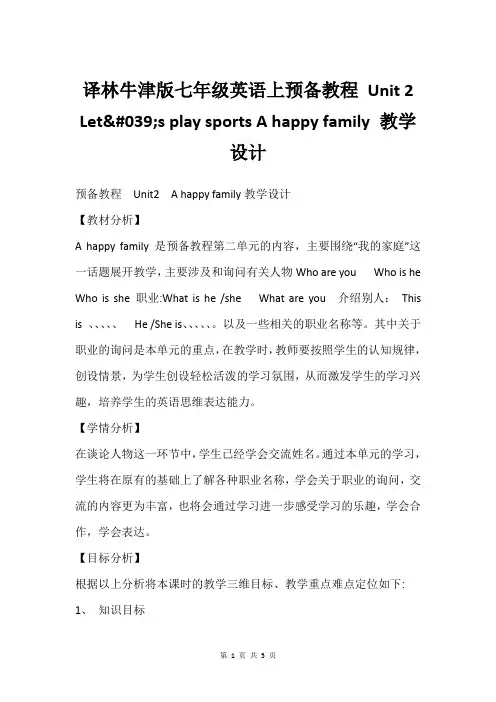
译林牛津版七年级英语上预备教程Unit 2 Let's play sports A happy family 教学设计预备教程Unit2 A happy family教学设计【教材分析】A happy family 是预备教程第二单元的内容,主要围绕“我的家庭”这一话题展开教学,主要涉及和询问有关人物Who are you Who is he Who is she 职业:What is he /she What are you 介绍别人:This is 、、、、、He /She is、、、、、。
以及一些相关的职业名称等。
其中关于职业的询问是本单元的重点,在教学时,教师要按照学生的认知规律,创设情景,为学生创设轻松活泼的学习氛围,从而激发学生的学习兴趣,培养学生的英语思维表达能力。
【学情分析】在谈论人物这一环节中,学生已经学会交流姓名。
通过本单元的学习,学生将在原有的基础上了解各种职业名称,学会关于职业的询问,交流的内容更为丰富,也将会通过学习进一步感受学习的乐趣,学会合作,学会表达。
【目标分析】根据以上分析将本课时的教学三维目标、教学重点难点定位如下: 1、知识目标(1)能听懂、会说、会默写单词:policeman doctor nurse driver teacher(2)能听懂、会说、会默写主要句型:What is he /she He /she is a doctor. Who is that man He is my uncle .(3)获得运用所学语言句型交际能力。
2、能力目标培养学生初步询问职业的交际能力,能与他人合作交往的能力。
3、情感目标激发学生的英语学习兴趣,唤起学生对未来职业的向往热情。
4、教学重点和难点5、单词:policeman doctor nurse driver teacher 的拼写。
6、句型:What is he /she He /she is a doctor. Who is that man He is my uncle 的掌握。
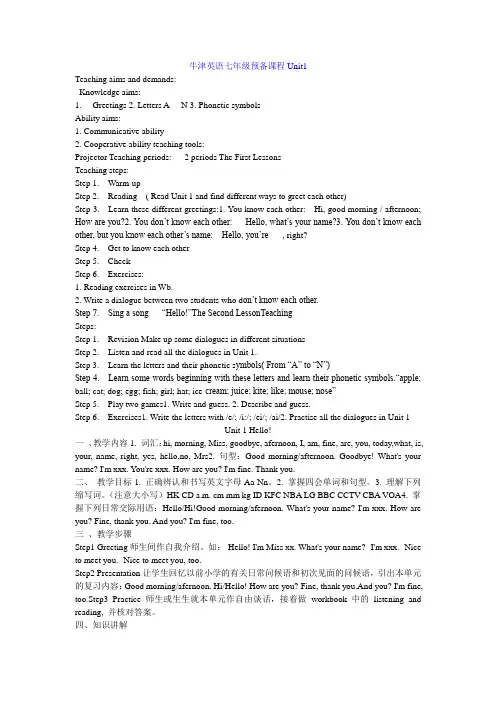
牛津英语七年级预备课程Unit1Teaching aims and demands:Knowledge aims:1. Greetings2. Letters A----N3. Phonetic symbolsAbility aims:1. Communicative ability2. Cooperative ability teaching tools:Projector Teaching periods: 2 periods The First LessonsTeaching steps:Step 1. Warm-upStep 2. Reading ( Read Unit 1 and find different ways to greet each other)Step 3. Learn these different greetings:1. You know each other: Hi, good morning / afternoon; How are you?2. You don’t know each other: Hello, what’s your name?3. You don’t know each other, but you know each other’s name: Hello, you’re ----, right?Step 4. Get to know each otherStep 5. CheckStep 6. Exercises:1. Reading exercises in Wb.2. Write a dialogue between two students who d on’t know each other.Step 7. Sing a song “Hello!”The Second LessonTeachingSteps:Step 1. Revision Make up some dialogues in different situationsStep 2. Listen and read all the dialogues in Unit 1.Step 3. Learn the letters and their phonetic s ymbols( From “A” to “N”)Step 4. Learn some words beginning with these letters and learn their phonetic symbols.“apple; ball; cat; dog; egg; fish; girl; hat; ice-cream; juice; kite; like; mouse; nose”Step 5. Play two games1. Write and guess. 2. Describe and guess.Step 6. Exercises1. Write the letters with /e/; /i:/; /ei/; /ai/2. Practise all the dialogues in Unit 1Unit 1 Hello!一、教学内容1. 词汇:hi, morning, Miss, goodbye, afernoon, I, am, fine, are, you, today,what, is, your, name, right, yes, hello,no, Mrs2. 句型:Good morning/afternoon. Goodbye! What's your name? I'm xxx. You're xxx. How are you? I'm fine. Thank you.二、教学目标1. 正确辨认和书写英文字母Aa-Nn。
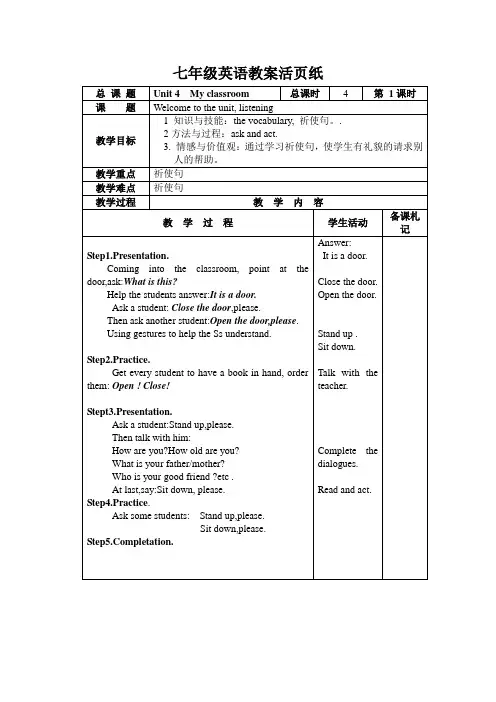
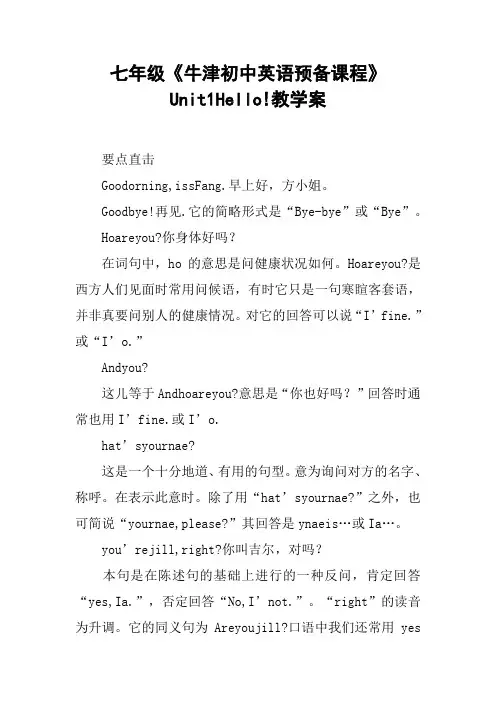
七年级《牛津初中英语预备课程》Unit1Hello!教学案要点直击Goodorning,issFang.早上好,方小姐。
Goodbye!再见.它的简略形式是“Bye-bye”或“Bye”。
Hoareyou?你身体好吗?在词句中,ho的意思是问健康状况如何。
Hoareyou?是西方人们见面时常用问候语,有时它只是一句寒睻客套语,并非真要问别人的健康情况。
对它的回答可以说“I’fine.”或“I’o.”Andyou?这儿等于Andhoareyou?意思是“你也好吗?”回答时通常也用I’fine.或I’o.hat’syournae?这是一个十分地道、有用的句型。
意为询问对方的名字、称呼。
在表示此意时。
除了用“hat’syournae?”之外,也可简说“yournae,please?”其回答是ynaeis…或Ia…。
you’rejill,right?你叫吉尔,对吗?本句是在陈述句的基础上进行的一种反问,肯定回答“yes,Ia.”,否定回答“No,I’not.”。
“right”的读音为升调。
它的同义句为Areyoujill?口语中我们还常用yes代替right。
如:“you’rejill,yes?”。
缩写形式I’是Ia的缩写形式;Ia是I’的完全形式。
hat’s是hatis的缩写形式;hatis是hat’s的完全形式。
you’re是youare的缩写形式;youare是you’re的完全形式。
Hello!你好!Hello通常用于以下四种情况:打招呼、打电话,表示惊讶或引起对方的注意。
意为“喂”、“你好”等。
Hello 等于hi,多用于非正式场合。
hi比hello使用时更随便,在美国青年人中使用更为普遍。
但是学生见到老师打招呼一般不说Hello,而应该说Goodorning!或Hoareyou?以免被认为不够礼貌。
0.有关字母的大小写句子开头个字母要大写。
人称代词单数主格I在句中任何位置都要大写。
例如:HeandIarestudents.他和我是学生。
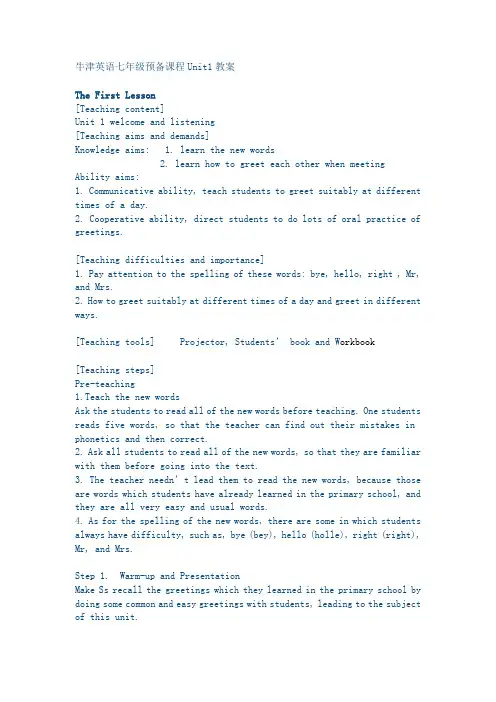
牛津英语七年级预备课程Unit1教案The First Lesson[Teaching content]Unit 1 welcome and listening[Teaching aims and demands]Knowledge aims: 1. learn the new words2. learn how to greet each other when meetingAbility aims:1. Communicative ability, teach students to greet suitably at different times of a day.2. Cooperative ability, direct students to do lots of oral practice of greetings.[Teaching difficulties and importance]1. Pay attention to the spelling of these words: bye, hello, right , Mr, and Mrs.2. How to greet suitably at different times of a day and greet in different ways.[Teaching tools] Projector, Students’ book and W orkbook[Teaching steps]Pre-teaching1.Teach the new wordsAsk the students to read all of the new words before teaching. One students reads five words, so that the teacher can find out their mistakes in phonetics and then correct.2. Ask all students to read all of the new words, so that they are familiar with them before going into the text.3. The teacher needn’t lead them to read the new words, because those are words which students have already learned in the primary school, and they are all very easy and usual words.4. As for the spelling of the new words, there are some in which students always have difficulty, such as, bye (bey), hello (holle), right (right), Mr, and Mrs.Step 1. Warm-up and PresentationMake Ss recall the greetings which they learned in the primary school by doing some common and easy greetings with students, leading to the subject of this unit.Step 2. Welcome to this unit1.Ask students to read the four dialogues of this part for twice, and get ready for the following questions to check if the students understand the meaning of the dialogues:Who is Andy? Who is Millie? Who is Lily? Who is Nick? Who is Miss Fang? When they meet,what do they say? When they meet in the morning, what do they say? When they part(分别), what do they say?2.Teach students some similar words and similar sentences of the four dialogues, and at the same time ask them to replace all of the names in the dialogues with the thoses of their classmates. Therefore, students can make another four dialogues of their own and of different patterns but of the same meaning.For example, Hi= Hello, Good morning= Good morning to you,Good bye= Bye-bye, Bye, See you, see you around, see you later3.Pair work and a show timeStep 3 Listening1.Pre- listening.There is a clock on the wall in Picture 1 of Part A, so ask Ss for the correct time. After that the teacher guides the students to observe the times of the other three dialogues in this part and teaches the different ways of greeting.2.Ask students to do the listening exercises on the tape and tick thecorrect answer.3.Do some post-listening work. Guide students to replace all of thenames in the dialogues with the names of their classmates and use some similar words and similar sentences to make another dialogue of their own, so that Ss can know the different ways of greeting.For example, Good afternoon= Good afternoon to you, How are you = How are you doing,I’m fine= I’m OK, OK, Fine, Good, Great, hi= hello, And you= What about you,Thank you= Thanks4.Pair work and a show time5. Summary, ask Ss to find and learn these different ways to greet each other.1). You know each other:Hi, good morning / afternoon; How are you?2). You don’t know each other:Hello, what’s your name?3). You don’t know each other, but you know each other’s nam e:Hello, you’re ----, right?Step 4 Further knowledge and ability1.How are you?的回答一般是肯定,它的不同回答有:Fine, thank you. / I'm fine, thank you. / Not bad, thank you. /I'm OK/very well / All right./ Just so-so.身体状况确实不好,我们可以说:Not so good / Terrible / I don’t feeling very well.2. 对女性和男性的称呼如下:对男性我们一律称Mr. so and so,对未婚女性我们称Miss so and so, 而对已婚和不明婚姻状况的女性分别称Mrs. so and so, 和 Ms so and so.,并将Mr. Mrs.或Miss,Ms放在姓之前。
七年级《牛津初中英语预备课程》教学案Unit 6 In the park要点直击1.on, in, under, behind, between等在英语中为介词,用来表达东西在哪儿。
(1I’m between the trees. 我在两棵树之间。
between意为“在……(两者之间”,通常与and连用。
例如:I’m between Millie and Peter.我在米莉和皮特之间。
(2Peter is in front of the gate. 皮特在大门前。
2. in front of意思是“在……的前面”,表示某个物体在某个范围之外的前方。
如:There isa big tree in front the building. 楼前有一棵大树。
in the front of意思为“在……前部”,表示某物在某范围之内的前部。
如: There isa teacher’s desk in the front of the classroom.教师前面有一个讲台。
3. Where is the bird? 小鸟在哪儿?It’s in the tree. 在树上。
in the tree(在树上强调的是外部事物在树上。
on the tree(在树上则表示本身长出的东西在树上,如花,树叶,果实等。
4. What about shops? 商店呢?What about …? 意思是“……怎么样?”表示一种询问或建议。
如:I’m a student. What about you? 我是学生,你呢?5.What’s under the tree? 树下有什么?What’s + 介词词组?是一个非常重要的句型,用来询问“某地于什么”。
回答这个句型通常“There be句型”,有时还可用I t’s …或They’re …6. It’s not very big but it’s beautiful. 虽然它不是很大,但是很漂亮。
七年级《牛津初中英语预备课程》教学案Unit8 Our things要点直击1.Do you have a Walkman, Millie?米莉,你有个随身听吗?2.What about Lily?莉莉呢?根据上下文判断,这句话的完整意思是:莉莉有一些漫画书吗?what about sb./sth. 某人/某物怎么样3.Is this model plane yours, Peter? 这架飞机模型是你的吗,彼特?model plane 飞机模型4.Is it Andy and Millie’s? 它是安迪和米莉的吗?这里的Andy and Millie’s是名词所有格形式, 提问时用whose。
5.lockers for students 学生专用存物柜5.What d_____Lily have in her box?6.Is this m_____ plane Peter’s ? Yes, it is.7.Is that blue scarf y______,Jill?二、用所给词的适当形式填空。
1.______(who) tennis racket is this ?2.—Is this your ______ (brother) photo?—No, it’s ______ (my).3.What _____ they _____ (have) in their bags?4. This is not Lucy’s sticker.______(she)is at home.5.My twin sister ______(have) two red _______ (scarf).6.It’s not ______(they) ball.._____(they)is under the desk..7.Is it _______________ ( Lily and Lucy)bedroom?三、翻译下列词组。
英语教案:初中英语预备课程(Starter) Unit 12 A birthday partyPeriod (I)一教学内容:Wele to the unit + Speaking二教学目的与要求1 理解和掌握一些新词汇,如:birthday, party, soon, present, get, chocolate, toy, sweet, etc.2理解掌握问句“Would you like……”及其回答3 初步掌握特殊疑问句,如:What do you want to buy? etc.三教学难点及重点1 掌握一些常用词组的缩写形式2 熟练掌握特殊疑问句四教学用具:图片(生日蛋糕)、卡片(请柬)五教学步骤Step A Warming upStage 1 Talking about birthdayQuestions : What’s this?(show them a picture of cake)What will you think when you see the cake?Can you tell me which date is your birthday?Did you have a birthday?What present do you get for your birthday?这一部分通过一系列问题活跃课堂气氛并引出即将学习的内容Step B PresentationStage 2 Wele to the unit(1)打开书本,教师读课文,就课文内容提问,然后带领学生朗读,要求学生集体朗读,最后叫同学到前面,用动作,表情来进行表演。
(2)问学生:“What do you want to get for your birthday?”“Would you like……”让学生掌握这两个问句及其回答,同时掌握won’t= will not , I’d love = I would love , Would you love(like)……?= Do you want……?(3)接下来学习Part B部分,带领学生读课文上的词组,并提醒他们此处banana 和sweet 用的是复数形式,然后让学生读Stage 3 Speaking(1)What is this ? (show them an invitation card) 通过这个问题引出单词“invitation”,然后让学生合上书本,教师读课文或放录音并提问学生。
Lesson 1 Nice to meet you!Part A教学目标: 1。
Master the letters from Aa to Nn. Can read and write them correctly。
2. Learn how to greet others。
Can make conversations with new friends.重点1. Master the words:I,You,We, I am=I’m, You are=You’re,We are=We’re2. Master the sentence patterns: I'm——-. Nice to meet you.难点1. Master the sentence pattern: Are you-—-? And can give correct answers.2. Can make conversations with new friends。
【个体学习】1.Write the letters from Aa to Nn。
Make sure everyone can read and write correctly.2.Introduce myself to the Ss and encourage them to introduce themselves.My name is —--. I’m—-—.3.Have the Ss introduce their partners freely。
4.Ask the Ss to look at the four pictures on page 6 and then read the conversations bythemselves。
Focus on the key sentences: Are you —-—? I’m ---. This is --—。
Lesson 1 Nice to meet you!※教学目标i掌握问候、介绍和告别的英语表达方式。
2学会运用人称代词提问和回答。
3学会用适当的形容词描述他人。
4学会写简单描述同学的小短文。
※教学准备i相关图片。
2学生的照片。
3配套磁带或光盘。
※教学步骤A Meeting new friendsStep I导入1 教师先打招呼并自我介绍:Hi, boys and girls, rm your new English teacher. Nice to meet you.询问学生该怎样回答,并把Nice to meet you.和Nice to meet you too.这两句写在黑板上。
2告诉学生以后见到你可以用“Hi, Miss/Mr 来跟你打招呼。
教师说:From now on, you can greet me with "Hi, Miss/Mr .…”并把该句写在黑板上。
Step II呈现教师说:Now you're in this new school. What do you think of it?鼓励学生回答:It's a nice school.教师说:This is a new class. Can you tell me your names?教师挥手跟任意一位学生打招呼并自我介绍:Hi, I'm Miss/Mr….鼓励学生用“Hi, I'm…•”回应。
3安排同桌的学生用“Hi, 互相介绍。
教师说:Now introduce yourself to your partner, please. Don't forget to use "Hi”.4 告诉学生:Today we're going to meet four new friends. Listen to the tape.教师播放录音,听完后问学生:Can you tell me their names?让学生集体回答。
5让学生看A1部分的图片,然后提问:Picture 1: Who are they? (They are Millie and Jill.)Picture 2: What are they talking about? (They are talking about their school). Picture 3: Who is introducing Jill? (Millie is introducing Jill.)Picture 4: Who is Andy? (He is Millie's cousin.)6播放录音,要求学生集体跟读对话,教师说:Now read the conversation after the tape.播放录音时可一句一停,以便学生跟读。
7请学生看图复述对话内容。
8把学生分成三人一组进行分角色朗读,并给学生几分钟时间准备,之后请两到三个小组上台表演。
让他们用自己的真实姓名表演,达到活学活用的效果:Would you pleas e come to the front and act out the conversation for us? You may use your own names to greet each other. Step III 练习1把学生分成三人一组,一人介绍另外两人彼此认识。
Sample conversationSI: This is my new friend ....S2: Hi, .... Nice to meet you.S3: Hi, .... Nice to meet you too.2全班同学互相认识后,以小组为单位从前到后依次快速打招呼。
使用句型“Hi, •…”和“Are you…?”并用yes/no回答。
Step IV呈现1呈现A1部分的学生图片,教师问:Who's the girl/boy?鼓励学生用人称代词he、she、they 回答问题。
2完成A2部分的练习。
3教师介绍人称代词以及be动词的完整和缩写形式,向学生解释:I'm = I am、You're = You are等,前者是后者的缩写形式。
要求每位学生用I、you、we、he、she、they、it来介绍同学和教室里的物品,内容不重复。
Step V巩固1背诵对话。
2完成书后配套练习的相关部分。
B Photos of friendsStep I导入1教师在黑板上画一只钟,显示上午的某一个时间,问学生此时应该怎样用中文跟教师或同学打招呼:At this time of the day, how do you greet your teachers or classmates in Chinese?当学生回答“早上好”时,教师说出“Good morning!”并把该句写在黑板上。
2假设当时是上午九点,让学生用“Good morning!”与同桌互致问候:It's nine o'clock in the morning now. How do you greet your partner?Step II呈现1教师和一位学生进行示范问候:Good morning!告诉学生可简略回答:Morning!2 告诉学生如何问候认识的人:Now I know you all and you all know me. How do we greet each other when we meet again? I would say "How are you?"然后要求学生跟读:Now repeat it after me: How are you?重复多次,确保每位学生都能正确模仿。
3当学生最后一次跟读“How are you?”时,教师回答:I'm fine, thank you.并在黑板上画一张笑脸。
教师再将“I'm fine, thank you.”重复多遍让学生跟读,并把“How are you?”和“I'm fine, thank you.”都写在黑板上。
然后问能力较弱的学生:How are you?启发他们回答:I'm fine, thank you.还可启发能力较强的学生进一步询问“And you?”教师回答:I'm fine too.4同一列学生前后依次问答,练习这段对话。
呈现B1部分的学生图片,问:Who are they?讨论每张图片中的学生:Who is he/she? Is she short? Is he strong?让学生用yes/no回答。
6学生分角色朗读对话。
7鼓励学生指着课本上的图片表演对话。
8展示几张班上学生的照片,要求学生模仿B1部分用真实信息改编对话。
Step III 练习1完成B2部分的表格。
2完成表格填写后,教师每说一个人称代词,学生齐声说出相应的be动词形式。
教师也可依次请一位学生来回答,最后帮助学生总结规律。
Step IV呈现教师说:Now I want to know if I can remember all your names.走到学生面前问:Are you right?引导学生回答:Yes, I am./No, I'm not.也可问学生同学的姓名:Is he/she right?引导学生回答:Yes, he/she is./No, he/she isn't.2让学生两人一组用这种一般疑问句进行对话。
3引导学生操练B3部分的对话,用一般疑问句向学生提问:Are you ...? Is she tall? Are they classmates?让学生用yes/no回答,并在其后用肯定或否定形式完整表述。
4提醒学生注意否定的缩写形式。
5教师播放B3部分的录音,要求学生集体跟读对话。
教师说:Now read the conversations after the tape.播放录音时可一句一停,以便学生跟读。
6学生两人一组用同学的真实身份模仿B3部分的句型进行对话。
Sample conversationSI: Is she thin?S2: No, she isn't. She isn't thin.SI: Is she ...?S2: Yes, she is. She's ....Step V巩固1背诵对话。
2完成书后配套练习的相关部分。
C Greeting each otherStep I导入1教师在黑板上画一只钟,钟面显示两点整。
教师说:It's two o'clock in the afternoon. Can I say “Good morning" to you?启发他们回答:No.进一步引入“Good afternoon!”并将该句写在黑板上。
2教师假装要离开,边走向门口边对学生挥手说“Goodbye!”,鼓励学生用“Goodbye!”回应:I'm leaving. I say goodbye to you. What do you say to me?鼓励学生说出“Goodbye!”然后把“Goodbye!”写在黑板上。
告诉学生,在和熟悉的人告别时还可以简单地说“Bye”或“Bye-bye”。
教师说:You can say "Bye!" or "Bye-bye, for short.Step II呈现1走到一个学生面前说:Hello! What's your name?启发学生回答:Hello! I'm ....告诉学生,跟“Hello”相比,“Hi”更口语化:"Hi" is more informal than "Hello". We usually greet our friends with "Hi”.3与多位学生练习这个对话,直到被提问的学生都能正确回答为止。
4组织学生开展活动,让他们用“What's your name?”这一问句去主动认识那些还不熟悉的同学:Please go to those classmates that you don't know and ask them their names.5 告诉学生Millie正在跟别人打招呼:Millie is greeting other people. Now let's say who they are. When do they meet? What does Mrs Li say to Millie?6让学生看Tip部分,并解释Mr、Mrs、Miss、Ms加姓氏的用法:课前准备一些不同年龄和性别的人的图片。